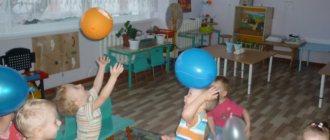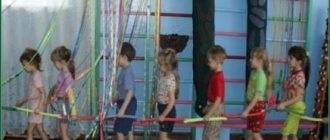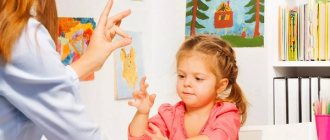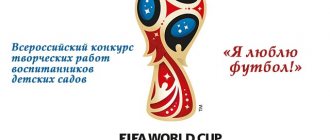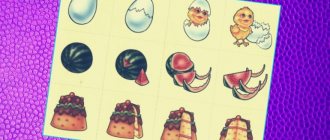Health-saving technologies
In preschool educational institutions, three groups of health-saving technologies are most often used:
- Technologies for preserving and promoting health.
- Technologies for teaching a healthy lifestyle.
- Corrective technologies.
Technologies for preserving and promoting health:
- game stretching;
- dynamic pauses;
- outdoor and sports games;
- relaxation;
- finger gymnastics;
- gymnastics for the eyes;
- breathing exercises;
- invigorating gymnastics;
- corrective gymnastics.
Technologies for teaching a healthy lifestyle:
- Physical education classes;
- classes in the pool;
- rhythm;
- biofeedback (BFB);
- communicative games, conversations from the “Health” series;
- acupressure self-massage.
Corrective technologies:
- technologies for the development of the emotional-volitional sphere;
- behavior correction;
- psycho-gymnastics;
- art therapy;
- articulation gymnastics;
- technology of musical influence;
- fairytale therapy;
- color influence technologies.
The implementation of these technologies in practice is carried out by physical education instructors in close cooperation with preschool teachers, in the conditions of specially organized forms of health-improving work and in various forms of organizing the pedagogical process: during educational activities, in the free activity of children, during routine moments, on walks.
One of the important components of the motor regime is morning exercises. Morning exercises are carried out daily before breakfast for 6-10 minutes. outdoors (under favorable climatic conditions) or indoors. There are different types and options for morning exercises.
For example:
- a set of musical and rhythmic exercises;
- morning exercises of a playful nature;
- morning exercises in the form of a health jog;
- a set of exercises with the simplest type of exercise equipment (Health disc, children's expander, children's dumbbells, gymnastic roller, etc.);
Usually the morning exercise complex is repeated for two weeks. The morning exercise complex is carried out under the guidance of a physical education instructor. Children in the preparatory group are quite capable of independently reproducing the entire complex after several repetitions. During the organization, musical accompaniment is necessary.
Directly organized educational activities on physical development are the main form of physical education for preschool children, mandatory for all children, carried out all year round.
Physical education is a mandatory part of ECD. Any direct educational activity not related to movement is a heavy burden on the body of preschoolers, since they are characterized by instability of nervous processes. They quickly get tired, the stability of attention decreases, children lose interest in activities, which, of course, negatively affects its effectiveness. At the moment when children show the first signs of overwork, it is advisable for the teacher to conduct physical education. This is a set of general developmental exercises (arm exercises, bending, squats, jumping, skipping, walking) with text accompaniment, or dance, improvisational movements with musical accompaniment.
During the long break between classes, a motor warm-up is carried out. Usually it consists of 3-4 general developmental exercises, or voluntary movements of children using a variety of physical education aids. Warm-up duration no more than 10 minutes: 6-8 minutes. for active movement and 1-2 minutes for relaxation exercises.
Outdoor games and physical exercises while walking. Outdoor games are designed to improve the motor skills children have already mastered and develop physical qualities. Outdoor games are divided into outdoor games with rules (plot and non-plot) and games with elements of a sports game (football, volleyball, basketball, badminton, small towns); based on the predominant type of movement (running, jumping, throwing, etc.) and the degree of muscle tension (high, medium and low mobility). Conducted daily and in all age groups. Outdoor games and exercises for the development of physical qualities of children of senior preschool age.
Goals and objectives of physical education of preschool children
The main goal of family and public physical education of preschool children is preparation for work and life. Before entering school, children need to obtain a number of knowledge and motor skills that will help them better master the school curriculum at different stages of education, get sick less, and develop physically correctly. Physical exercise will help them with this.
The main objectives of physical education, the role of which is difficult to overestimate, are:
- protecting the child’s health, strengthening the immune system, hardening the body;
- creating the necessary conditions for the formation of motor skills, accustoming to regular physical activity;
- full physical development (proportional physique, increased endurance, both physical and mental);
- nurturing interest in active physical activity, creating a need for it;
- practicing basic types of motor activity (running, jumping, walking, throwing, throwing, swimming, and so on);
- prevention of flat feet, formation of correct posture;
- development of endurance, agility, strength and speed;
- formation in the child of a complex of knowledge about the benefits of physical education, rules and hygiene requirements.
Development of flexibility
"Relay with hoops"
The quality of the task and speed are noted. The players stand in 2 columns. Hoops are placed at a distance of 5 - 6 meters from the columns - 1 against each team. At the teacher’s signal: “1,2,3 – run!” the first in the column run to the hoops, lift them up, climb into the hoop, put it in place, run to their column, touch the hand of the next player and stand at the end of the column. The next player runs. The group of children who completes the obstacle course first wins.
"Make a figure"
The expressiveness of the figure is noted. A presenter is selected. Children move freely around the playground. At the leader’s signal (strike on the tambourine or the word: “Stop!” everyone stops in some position and does not move. The leader goes around all the “pieces” and chooses the one he likes best. This child becomes the leader.
"Little Entertainer"
Perform all exercises at a slow pace.
- Tilts forward and backward:
- forward sitting;
- back, kneeling;
- forward and backward while standing.
- "Martin". Standing on one leg. The body is arched, the head is raised, arms to the sides. The toe of the raised leg is pulled back. The holding time can be increased to 10-20 seconds.
Ball relay
Attention is drawn to the correct execution of the exercises. The players are divided into 2 squads and stand in 2 columns. Feet are shoulder-width apart. The first in the column is given a ball. At the teacher’s signal: “Up!” - the children raise their hands up and the one standing first passes the ball over the head to the one standing behind, who is the next, etc. When the last child receives the ball, he runs to the teacher and gives him the ball. The ball is passed over the head 1-2 times, then the command is given: “Down!” (the ball is passed between the spread legs).
Methods
There are two main groups of methods:
1. Specific. This group includes strictly regulated exercises, with the help of which the child is taught motor actions, improves them, develops new physical skills, and increases endurance. Specific methods include gaming and competitive methods.
2. General pedagogical. They are divided into verbal and visual. In the first case, information is presented to the child in the form of explanations on how to perform this or that exercise, instructions, commands, lectures, and comments. Visual methods involve a step-by-step demonstration of certain motor actions that the child must repeat (by his own example, by showing educational videos, special pictures, and creating visual references). The method of presenting the material is selected based on the specifics of age. For example, while young children perceive visual explanations best, preschoolers already understand verbal instructions perfectly.
Agility development
"Hot potato"
Pass the ball carefully into each other's hands. Children stand in a circle, hands behind their backs. The leader stands in the circle. At the teacher’s signal, the children begin to pass the “potato” (ball) to each other. At this time, the presenter asks the players to show their hands. If the child has a ball in his hands, he stands in a circle (becomes the leader) and the game starts over.
"Mousetrap"
After the mousetrap has slammed shut, the mice must not crawl under the hands of those standing in the circle.
The players are divided into unequal groups. The smaller group holds hands and forms a circle. They represent a mousetrap. The remaining children (mice) are outside the circle. Those depicting a mousetrap walk in a circle, saying:
“Oh, how tired the mice are, they chewed everything, ate everything.
Beware, you cheaters, we will get to you.
Let’s set up mousetraps and catch everyone now!”
Children stop, raise their clasped hands, forming a gate. Mice run in and out of the mousetrap. At the teacher’s signal: “Clap!” Children standing in a circle lower their hands, squat - the mousetrap slams shut. Mice that did not have time to run out of the circle are considered caught. They stand in a circle and the mousetrap gets bigger. When most of the children are caught, they change roles and the game resumes.
"Hunters"
Hunters are not allowed to go beyond the line. The “animals” walk freely around the site. Three or four “hunters” stand in different places, each holding a small soft ball in their hands. At the signal, all the “animals” stop, and each “hunter” easily throws his ball at them. Those hit by balls replace the “hunters”. It is allowed to dodge balls while standing still.
"Hockey"
Try to get the ball to the goal without interfering with someone else. Players of 2 teams are located on rectangular platforms. Gates are marked on opposite sides of the site. Players with sticks or gymnastic sticks try to score a small ball into the opponent's goal. The game takes place within the court for a while. There are no goalkeepers.
Development of speed
"We are funny guys"
If the trap has not caught anyone, then after 2-3 runs a new trap is selected. Children stand on one side of the playground outside the line. A line was also drawn on the opposite side of the site. To the side of the children, approximately in the middle between the lines, there is a trap.
Children:
“We are funny guys, we love to run and jump.
Well, try to catch up with us. 1,2,3 - catch!
The children run to the other side of the playground, and the trap catches up with them. The one who touches the trap is considered caught. He steps aside. After 2-3 runs, those caught are counted and a new trap is selected.
"Migration of Birds"
Be careful when standing on the apparatus. Children run scattered around the playground, pretending to be birds. At the teacher’s signal: “Wind, storm!” - climb the gymnastic wall or stand on benches. On the signal: “Nice weather!” — children run around the playground.
"Falling Stick"
A quick response to a signal is encouraged. The players settle down in numerical order and, having memorized their numbers, stand in a circle. The driver places a stick in the center of the circle, holding it with his hand. Having shouted out someone's number, he releases his hand and runs out of the circle. The player whose number was called must run out and grab the stick before it falls. If he managed to do this, he returns to his place, and the previous driver continues to drive. If the player does not have time to hold the falling stick, he changes places with the driver.
"Empty place"
Children standing in a circle do not interfere with the movement of those running. The players form a circle. The driver runs around the circle, spots someone and continues to run in the same direction, and the stained player runs in the opposite direction. Everyone tries to quickly run around the circle and stand in an empty place. Those who do not have time to take a seat become the driver, and the game continues. The player's spot, the leader must give way to him, moving one step away from the circle.
Strength development
"Who's next"
Perform only 1 push at a time. Children are divided into several teams and line up in parallel columns in front of a line that cannot be crossed. The first numbers push the medicine ball forward. A new line is drawn where the ball stops. The next participants push the ball from the new line. The team with the ball at the greatest distance from the starting line wins.
"Don't hit the ball"
Control the strength of hand movement. Three or four guys stand around a ball lying on the floor and put their hands on the shoulders of their partners standing next to them. At the signal, they begin to push each other so that someone touches the ball. The person touched is eliminated from the game. The last one remaining wins.
"Who Can Resist"
Control the force of the blow. Players playing in pairs sit facing each other at arm's length. Heels and toes together. Everyone tries to throw one or both hands into the opponent’s palm to throw him off balance. You can dodge blows by removing your palms. A player who lifts his feet off the ground or moves from his place is considered defeated.
"Tug of War"
Try to stay on your feet. If one of the players falls, the game stops. Two teams with an equal number of players take the ends of the rope. 3 lines are drawn on the ground at an equal distance between them. A bow is tied to the middle of the rope, which is aligned with the center line. On command, players try to pull the rope to their side. The team that pulls the bow on the rope to its line wins.
Endurance development
"Who takes longer"
Children jump until they make a mistake. Jumping rope in place, moving forward.
"Fun Relay Races"
The quality of the exercises and speed are noted.
Relay races with different task options:
- jumping;
- run;
- passing the ball;
- crawling;
- pulling up on a bench on your stomach, etc.
"Tag"
Try to maintain a half-squat position while playing. Players are positioned within the court in a semi-squat position. One of the players (“tag”) catches, and the rest run away. Both the “tag” and the runners must move in a semi-squat position. Having caught up with one of the players, “Salka” touches him with his hand. It is possible that the driver spots other players not with his hand, but with the ball. The one who straightens up or runs out of the area becomes a “tag”.
"Jumpers"
Players who touch the line or stop are eliminated from the game. Players face the wall and raise their hands up. Lines are drawn at a distance of 15-20 cm above the fingers of each player. Players on command begin to jump up non-stop, trying to touch the wall above the corresponding lines with their palms. The one who completes the most jumps wins.
Exercise after a nap allows you to increase children's activity, improve their emotional mood, and actively prevent postural disorders and flat feet. It has a variable nature and varying degrees of duration from 7-15 minutes. After performing 3-4 general developmental exercises while lying in bed (on your back, on your side, on your stomach), you jog along massage paths (health paths) every day.
Hardening is the most important part of the physical education of preschool children. In the preschool educational system, hardening should be considered as the conscious application of a system of measures that increase the body’s resistance, developing the ability to quickly and without harm to health be applied to various environmental conditions.
Principles of hardening: gradualism, consistency, systematicity, complexity, personality-oriented approach.
Types of hardening:
- daily health walks in the fresh air;
- water procedures: local (washing, washing hands with cool water, rinsing the mouth after each meal and after sleep with cool water or water at room temperature, foot baths, rubbing or dousing to the waist) and general (rubbing and dousing the whole body, swimming in the pool) ;
- air baths and walking along “health paths” after sleep; - walking barefoot.
Independent motor activity of children is organized by adults at different times of the day: in the morning before breakfast, during a break between classes, in free time after a nap, during a walk. When planning independent motor activity, it is important to take care of creating a physical education and play environment: allocate space sufficient for active movement, have a sufficiently diverse range of physical education aids (to create diversity and novelty in the physical education and play environment, alternating active and quiet activities of children).
Musical and rhythmic activity also has a beneficial effect on the physical development of children: overall health is strengthened: the development and growth of the musculoskeletal system; development of the respiratory, circulatory, cardiovascular and nervous systems of the body; Correct posture is formed, performance and vitality of the body are increased, and the development of coordination of movements is improved. It is closely related to physical culture, from which the main movements are selected: walking, running, jumping, which predominate in games, round dances, and dancing. Gymnastic exercises for the upper shoulder girdle, legs, and body are also used. These movements, with and without the inclusion of various objects (balls, hoops, flags, ribbons, etc.), are learned with middle-aged and older children. Some formations are used (walking in ranks, in a circle, in pairs, etc.), necessary for round dances and dances. They organize children's groups well and facilitate games and round dances.
Psycho-gymnastics is indicated for both children with character disorders and children with normal development for the purpose of psychophysical relaxation. It can be used by educators in everyday work with children, does not require special training, and no paraphernalia is used when conducting psychogymnastics. Elements of psycho-gymnastics in preschool educational institutions are used when conducting educational activities (they help create a positive emotional mood in classes, eliminate isolation and relieve fatigue), in correctional classes with a speech therapist and psychologist, during the free activity of children, or as special classes (studies, exercises, games) directions on the development and correction of the cognitive and emotional spheres of the human psyche.
Principles of education of physical qualities in preschool children
The basic principles for the formation of physical qualities in preschoolers are:
- harmonious personality development - achieved by combining physical education and the development of the child’s mental abilities;
- connection between physical education and real life - by playing sports, the child accumulates a large base of motor skills and physical abilities, which in the future contribute to the formation of an active life position and leading a healthy lifestyle;
- health-improving orientation - it is necessary to clearly (preferably by example) show children how to correctly perform certain exercises, design workouts in such a way that they correspond to the age and level of physical development of the child, gradually increase the load, but at the same time make sure that there is no increase excessive and so on.
